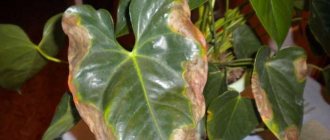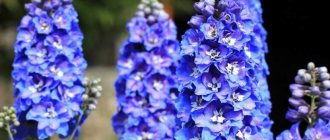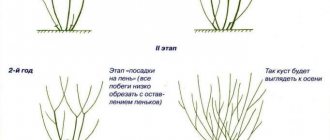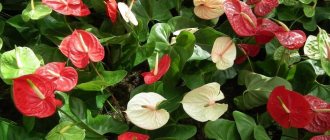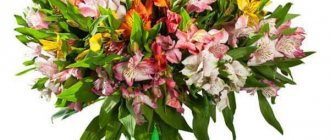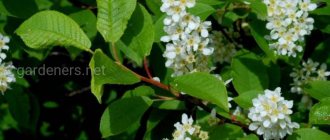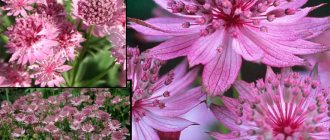Anthurium is beautiful and exotic, but when growing, you often have to deal with diseases of the capricious flower. Anthurium can become ill either from improper maintenance and care, or from various diseases; it is also attacked by pests. In this article we will look at all the most common ailments and diseases of anthurium and find out how to treat the plant.
How to save plants?
Sometimes it happens that no matter how carefully the grower cares for the flower, it still looks sick.
In this case, the problem may lie in unnecessary concern on the part of the person, that is, he begins to feed the flower with fertilizers, fill it with water, or place it in a place where there is too much light for it. To detect pests, you can visually inspect the soil and leaves, sometimes you will need a magnifying glass. Any change in green color already indicates that something is going wrong. If you smell the soil, then with root rot it acquires a special, pungent and unpleasant odor. In most cases, it is possible to revive the plant, but to do this you need to act quickly. If the bushes are infected with insects, any of those previously described, then their treatment comes down to increasing humidity and using fungicides. Neem oil is very effective. According to plant growers, a decoction of onion peels or even an alcohol solution helps a lot. The simplest method is to dilute the soap in water and spray the flower.
Reanimation with root rot is more difficult - it’s not enough to just spray. You will need to proceed step by step in the following sequence:
- first remove the root system;
- rinse it under water;
- remove all infected shoots;
- treat the roots with a fungicide;
- change the pot or disinfect the old one in a bleach solution;
- use new soil, and subsequently strictly monitor the quality of drainage and soil moisture.
If you do everything correctly, you can cure the flower, but if you start an infection, it will die.
You can save anthurium, just like Magnificum, by treating it with insecticides and fungicides, but it is only recommended to spray chemicals on the street. Pyrethrin helps a lot. This active ingredient is obtained from the chrysanthemum plant.
Some problems are not easy to deal with, so it is better to take preventive measures.
Darkening of green mass
If the leaves begin to darken, while the roots also suffer, and the stem section is limp, this may indicate the presence of an increased concentration of a microelement such as calcium in the soil substrate. An excellent solution to the problem is to transplant the flower into a higher quality soil mixture with a balanced composition, selected specifically for epiphytes (for example, soil substrate for orchids).
Fertilizer application must also be done correctly. It is not recommended to feed the soil too often; this can damage both roots and leaves.
How to rejuvenate anthurium
Rejuvenation occurs in two ways:
- activating aerial roots;
- restoring the functionality of the root system.
Aerial roots will begin to develop in a warm and humid environment. Therefore, the best way is to place the plant in a warm place and create a belt of sphagnum moss around the growth points of future roots. In a constantly moist substrate, the plant will take root within a week or two. Then this part can be cut off with a sharp, disinfected knife, sprinkled with crushed charcoal or ground cinnamon.
Such a seedling can be immediately rooted in a pot by preparing the necessary composition of tropical soil. Sphagnum will not interfere with this; the roots will break through the pores of the moss and reach the nutrient mixture.
But if the plant is very elongated, then in this way you can root another piece of the plant stem. During root growth, the plant is not watered so as not to spoil the idle soil. It is only sprayed from above. As a harbinger of the salvation of the anthurium, a new leaf will soon appear on the seedling. After this, create conditions for the anthurium to develop as quickly as possible. The plant will not need feeding for the first 2-3 months, the soil is full, but there are still few roots.
In order to thoroughly understand the condition of the rhizomes and understand how to revive the anthurium, you need to carefully wash all the roots, but they are very fragile. Then cut out the rotten and brown parts
If there are growth points on the light-colored roots, they will be visible. Place clean, disinfected and dried roots in a pot with a drainage layer and suitable nutrient soil. The container of the dish must correspond to the size of the root system. If there are few roots left, then the container should be small.
Plant the plant according to all the rules and wait for the result. Such work may not be necessary if only the above-ground part of the anthurium dies, the roots remain viable. Then, after cutting off the top for separate rooting, the entire pot is left at rest in a warm and bright place. After some time, young shoots should appear, which can later be planted. This is also one of the ways to rejuvenate anthurium.
A significant role in the revival of plants is played by subsequent care for them, as for a loved one who is recovering from a serious illness.
Appearance of brown spots
The cause of this problem may be too low an air temperature or improper application of fertilizers. How many degrees should the room be? At least 22C. Therefore, to eliminate the problem, you can additionally install heating. And for feeding, use only specially selected formulations that take into account the balance of essential nutrients, vitamins and microelements.
Another cause of brown leaves can be mealybug activity. To eliminate the pest, it is recommended to use insecticidal preparations (Karbofos).
With the right approach to cultivation, multiple problems with anthurium can be avoided.
Video anthurium disease prevention
Diseases caused by fungal parasites and their treatment
Fungal parasites are very dangerous for anthurium, so treatment must be started immediately.
Stem rot occurs due to waterlogging of the soil
Stem rot
A disease caused by a fungus that develops due to increased humidity in the air and soil. Dark water spots appear on the stem and then on the leaves. However, even in the first stages of the disease they have a whitish-gray tint.
The affected areas are removed and the bush is treated with the fungicide “Saprolo”.
Important! Before starting treatment, the pot with the bush is completely isolated from other plants in the house. "Blackleg"
"Blackleg"
This disease is characterized by the appearance of a blackened ring around the base of the stem. The area next to the lesion becomes soft and thins, causing the flower to die.
It can be cured by treating the soil with ash or biological antibiotics for plants.
Gray mold
It occurs mainly in young bushes due to improper watering and lack of drainage. First, the stems are affected, then the foliage, which becomes covered with a grayish coating.
The affected parts of the plant are cut off, and the anthurium is sprayed with Fitosporin.
Late blight
Leaves dry out and curl due to fungal infections.
Treated with fungicides and treatment with Bordeaux mixture.
Sooty mushrooms
A contagious disease caused by a fungus. Formed due to lack of nutrients and the appearance of aphids. The whole plant takes on a yellow tint.
Treatment begins with isolating the flower from other indoor plants, then removing the diseased parts. You can treat a diseased anthurium with potassium soap or Intavir.
Septoria
A very dangerous disease that appears due to elevated temperature along with high humidity. The leaves are affected by brown spots and begin to turn yellow along the edges.
The bush must be protected from other plants and treated with preparations that contain copper.
Important! Very often the bush cannot be saved, then you need to get rid of it along with the container. Anthracnose or powdery mildew
Anthracnose or powdery mildew
Appears due to infection with an infectious fungus. Yellow spots form on the foliage, with black dots in the middle. The disease can spread to the root system; pests are carriers.
Before treatment, reduce watering, then treat the flower with fungicides or spray it with copper sulfate.
Downy mildew
A sign of occurrence is a white coating on the leaves. Over time, it darkens and the plates die.
You need to regularly wash the bush with soapy water in the shower.
Rust often affects anthurium
Rust
Rust on anthurium leaves appears due to an infectious fungus. The shoots begin to become covered with yellow spots, then the leaf dries out completely.
It is necessary to cut off all infected leaves and stems, then treat them with Bordeaux mixture. You cannot spray the bush with various fungicides so that the infection does not spread throughout the rest of the bush.
Fusarium
A difficult to cure disease that is caused by too wet soil and indoor air. First, the peduncle becomes bent, then the leaves become covered with spots and plaque.
It is necessary to treat the soil with Glyokladin or completely change it by transplanting the plant into another container.
Fusarium wilt
Fusarium wilt is an infectious disease that can affect not only anthurium, but also many other indoor plants. It affects the root system, trunk and leaves of the flower. Characterized by unexpected and rapid withering of the entire plant. You can see a pale pink coating on the root collar. The disease develops rapidly in warm and humid conditions. So watering the flower will only accelerate the development of the disease.
Anthurium disease Fusarium wilt can be recognized at an early stage. If the gardener notices bending of flower stalks and yellowing of leaves. It is possible to overcome an infection only at the very beginning of its development. The anthurium bush needs to be removed from the pot, the roots should be thoroughly washed under running water, then soaked in a solution of foundationazole. Afterwards, trim off all affected and unhealthy areas on it. Then transplant the flower into fresh soil and a new pot. The bush is treated with copper-containing preparations.
Insect pests
Not a single flower is immune from damage to a flower by various pests. Even those in the cultivation of which all agrotechnical rules are observed. Parasites can infect the peduncle itself. The peduncle is the upper part of the stem on which the inflorescence grows. At the initial stages of development in orchids, it is difficult to distinguish the peduncle from the root. Here are some differences: •. More, leaf, stems and roots. Anthurium is quite resistant to attack by insect pests. However, sometimes he can become their victim. Such attacks weaken the vitality of the plant, sucking the juices out of it. Who affects anthurium and how to deal with insect pests:
- Aphids - feed on the juice from the anthurium, sucking it out. The affected bush withers, the leaves curl and a sticky coating appears on them. If the gardener notices the pest at an early stage, it will be enough to bathe the anthurium under a warm shower with laundry soap. If the flower is severely affected, treatment with insecticides is necessary. Aktara and Antitlin will do.
- Thrips - settle on the back of the leaves, leaving behind black dots there. Yellow spots of different sizes appear on the bush. Thrips can appear at any time of the year, but the spring and summer period is the peak of their development. Sick anthurium is sprayed with insecticides. For example, Tantrek, Acttelikt. The treatment procedure must be repeated every three to four days until the insects completely disappear.
- Scale insects - at the initial stage of the appearance of this pest it is not visible. This makes it much more difficult to fight him. Scale insects are glued to the leaf. They must be removed mechanically. That is, with a cotton swab or needle. Scale insects have a very dense shell, so treatment with chemical insecticides does not give the desired result. Oil solutions and kerosene can help remove scale insects. After them, you need to wash the anthurium with a solution of laundry soap.
- Spider mite - when it infects anthurium. Small yellow spots appear on it. The spots spread quickly and the leaf wilts. It is impossible to see a tick with the naked eye. But the cobweb is visible. It wraps the leaf, stems and flower. Why do they curl and wither? On the affected anthurium, you need to remove the cobwebs. After which the flower, pot and the nearest surface are washed with soapy water. If the plant is heavily infected, it is necessary to treat it with insecticides. If you do not care for the plant correctly, the spider mite may return.
Do not forget that during the treatment period it is necessary to isolate the diseased anthurium bush from other indoor flowers.
When treating and preventing diseases in indoor flowers, it is advisable to use biofungicides. They are safe for humans and animals. Still, it is better to prevent anthurium disease than to treat it
Follow agricultural cultivation techniques, regularly inspect the flower for the presence of fungi and pests, pay attention to any changes in the color saturation of the leaves. In a healthy anthurium they are dense, bright green
It is advisable to carry out preventive measures 1-2 times a month. This way you will protect your plants from diseases, and yourself from unnecessary hassle, and you will get beautiful flowering plants that breathe life and beauty.
https://stroy-podskazka.ru/anturium/bolezni-i-vrediteli/https://selo.guru/rastenievodstvo/derorativ/anturium/uhod-ant/ant-bolezn.htmlhttps://buton.info/anturium/ bolezni-anturiuma
Rust
A disease of anthurium leaves, such as rust, appears as a result of damage to the plant by rust fungi. They remain viable on the affected leaf. Rust affects not only the leaf itself, but also the stem of the anthurium. Brownish-rusty thickening spots appear on them, like pads. Small spots soon merge, affecting the entire leaf, which soon dries out. A diseased anthurium may bend to one side due to damage to the stem. An infected flower not only loses its decorative effect, but may even die. Because the fungus reduces his vitality. Causes of anthurium leaf disease :
- transfer of fungus from other plants;
- keeping anthurium in too dry conditions;
- too frequent and abundant spraying;
- keeping in an unventilated area.
Leaves with large areas of rust should be removed and burned. The remaining leaves are treated with fungicidal preparations. Bordeaux mixture is suitable both for the treatment of rust and for the prevention of diseases of anthurium leaves. During the treatment period, it is advisable to separate the anthurium from other indoor flowers to avoid infection.
Anthurium disease and its treatment
Anthurium, this beautiful, southern plant, without proper care, is prone to disease; at the slightest sign of a change in the appearance of the flower, it is necessary to begin its treatment. Diseases can occur if the requirements of agricultural technology are not followed; infection can be caused by insects.
A fairly common problem is that anthurium leaves turn yellow; this can only happen if the plant is not properly cared for at home.
The reasons for yellowing may be:
- chlorosis;
- burn from direct rays of the sun;
- the leaves are frozen.
First, you should check the watering; perhaps the plant does not have enough liquid or it is very hard. Most likely, fertilizing is needed or the amount of lighting needs to be increased. If the leaf has green veins and the leaf itself is yellow, then these are signs of chlorosis, then you need to start spraying the bush with iron chelate or algae extract. If a sunburn occurs, the leaves curl, which means you need to move the flower to another place.
Quite often you can hear the question why the leaves of anthurium dry out, although they try to take proper care of the plant at home. Most likely, this happened due to insufficient watering, the presence of drafts, perhaps, low air humidity in the room. In this case, you need to remove all damaged leaves and sprinkle the affected areas with wood ash or cinnamon powder.
For reference: It may be that this is a natural aging process during which old leaves die off. To detect serious diseases, you need to consult a specialist, because it is difficult to detect them on your own.
If brown spots appear on the leaves, this indicates too much watering; blackening of the foliage occurs due to improper replanting.
In addition to improper care, plants can contract an infection from the outside:
- septoria;
- anthracnose;
- fusarium wilt;
- rust.
When septoria leaves become brown and dry out, it is necessary to treat the anthurium with fungicides containing copper.
Anthracnose is also popularly called powdery mildew; with this disease, the leaves become dark brown in color and black dots appear in the center. At the first signs of the disease, it is necessary to remove all damaged leaves, change the soil, disinfect the roots, and reduce watering.
If the fungus has spread greatly, then it is necessary to apply fungicides, it is advisable to choose ones that are not very toxic; treatment with Bordeaux mixture helps a lot. If the plant cannot be cured, then it must be burned and the pot calcined or thrown away.
When rust occurs, the leaves become covered with orange tubercles; such a flower must be wiped with a fungicide solution, but not sprayed, otherwise the remaining leaves can be infected.
With Fusarium wilt, the entire bush begins to wither, and the flowers bend unnaturally. In such a situation, it is necessary to treat the ground with gliocladin, and remove all damaged parts.
Diseases from parasites
It is quite difficult to protect yourself from such diseases; the most dangerous are:
- aphid;
- scale insect;
- spider mite;
- thrips.
The latter are quite difficult to determine; if black dots appear on the back of the sheet, then this is them. Such a plant must be treated with insecticidal preparations, and for preventive purposes, the room must be ventilated more often. If you have spider mites, you should wipe the leaves with a solution of laundry soap.
For reference: The treatment process takes quite a long time and requires patience.
Anthurium diseases are easier to prevent than to treat, so you must constantly carefully examine the plant. With proper care and preventive measures, anthurium will grow well and delight you with its flowering.
Temperature
Temperature is very important, especially considering the tropical origin of anthuriums. Maintaining a stable and constant temperature is the key to good development. If the air is dry, the tips of the leaves may dry out. With sudden changes in temperature, which can be caused by drafts or differences between the heating and the window frame, problems with leaves and inflorescences also arise.
Solution to the problem: avoid sudden temperature fluctuations. Avoid drafts (especially when ventilating the room). Try to choose the very place in which your anthurium will feel ideal. If the air is dry, we use air humidifiers or wet spraying; you can also wipe the leaves with a damp cloth. When spraying flowering anthuriums, try not to get moisture on the inflorescences, otherwise they will begin to become stained.
Anthurium leaves turn yellow - it is necessary to find out the reasons and reconsider the growing conditions.
Signs of damage and causes
Sometimes it happens that “male happiness” withers or grows poorly, and strange spots appear on the surface of its leaves. If this is not a bacterial infection, in which in most cases the flower dies, then the plant can be revived. Anthurium dies in cases where the grower does not take any action.
There are many similar descriptions when defining different problems that a grower has to face. If the stem has dried up, most likely the soil was watered so rarely that the flower simply died from lack of moisture. When it turns black and rots at the base, on the contrary, there was too much water, or the soil is poorly drained.
If there is a stump left, but the roots have rotted, then you can try to propagate the plant while the shoots are still able to germinate.
Anthurium pest control begins with correctly identifying the invaders. Sucking insects such as aphids leave gnarled, mottled leaves over time. The infection process may also be accompanied by the appearance of ants, which love the sticky sweet dew that aphids leave behind. Insects cause damage to the plant, but not its death; the bush disappears only because there are a lot of aphids, and no human action should be taken.
Yellow growths on the foliage are a clear sign of spider mites. Thrips also cause variegated leaves and feed on new growth, just like mealybugs. All insects feed on plant sap, rich in carbohydrates. Once infected, the bush becomes faded and does not produce new growth. It is necessary to start a control program on anthuriums as soon as possible, otherwise the plant will lose a lot of strength.
Beginning gardeners often wonder why a flower has brown leaves. There may be several reasons for this, and such a symptom is not always associated with bacterial or other infection. Sometimes darkening of foliage is caused by:
- too much light;
- excess fertilizer;
- accumulation of salts in the soil;
- burn;
- microscopic mites;
- bacterial infection;
- nematodes.
Anthuriums grow best in the shade. About 60 percent sunlight indoors is ideal for them. Too much of it causes the leaves of the flower to become bleached, the tips turn brown, and eventually they die. But there is another side to the coin: too little light reduces flowering and can slow growth.
The use of large amounts of fertilizer or salt accumulation also causes the leaves to turn yellow, with yellow spots forming at the ends, which increase in size over time. You can wash off the salts by using distilled water for irrigation. Watering is done abundantly, the soil should drain well after it.
Bacterial infection through pores along the edges of leaves and wounds formed after pruning or insects
This pathogen loves moisture, so it is important to keep the foliage dry. The plant grower is required to disinfect all the tools, and then treat the sections with an activated carbon solution
Wilt disease, caused by the bacteria ralstonia solanacearum, first appears as leaves turning yellow and then turning brown. The stems of heavily infested anthuriums ooze brown mucus. The bacterial pathogen spreads in soil, water and on tools through contact. In this case, the bush often dies.
Spider mites are visible as tiny, moving dots at the beginning of an infestation. Their feeding on plant sap causes devastation of the leaves, followed by yellowing, darkening or bronzing. Heavily infected parts of the anthurium are cut off.
The foliar nematode primarily affects young anthuriums. In severe forms of infection, there is extensive loss of foliage and plant death.
Violation of growing conditions.
When growing anthuriums, it is necessary to take into account the lighting in the room ; if there is a lot of it and there is direct sunlight, they should be shaded. Or move them to a more different place. Be sure to take into account the temperature regime for growing anthurium.
Most anthuriums prefer warmer growing conditions; some can tolerate lower temperatures. It is necessary to pay attention to planting anthuriums and their transplantation. During such events, the plant experiences stress. Since its growing conditions are violated and your anthurium has to get used to the new conditions for some time after planting/transplanting .
Watering anthurium and feeding is perhaps the main point in growing. All types of anthurium are not allowed to overdry the earthen ball; they also react painfully to excess moisture. If the norms and characteristics of watering are violated, problems with the appearance of diseases may arise . Pests can also cause harm .
Regardless of the reasons that arose when growing anthurium, any change or violation of conditions is primarily reflected in the appearance of leaves and flowering. The leaves may turn yellow, become spotted, simply begin to fall off, and may be affected by pests and diseases. The decorative component may also be lost if it becomes cramped in its pot and it has outgrown it too much.
The falling of leaves on an anthurium does not mean that it is dying or sick. It is necessary to take into account the natural death of leaves during development and growth.
Anthurium leaves dry in spots - the reason is watering
Both insufficient watering and excess moisture are harmful to anthurium. The thick roots of the plant, which easily rot, are especially sensitive to excess water. Moist soil that does not dry out for a long time is an attractive environment for putrefactive bacteria, molds and fungi that parasitize plants.
The leaves are the first to react to irregular watering and the problems caused by it. If has brown spots on its leaves, this may be caused by moisture getting on the leaf blades. In the sun, such drops act like lenses and literally burn through living tissue.
It is even worse if the plant has been in a humid environment for a long time. In this case, tissue necrosis does not develop in spots on the anthurium leaves, but, starting from the edges, spreads to the entire leaf plate. You should try to dry the soil in a pot of such an anthurium, and if it is too dense, which provokes the accumulation of moisture, change the entire soil.
During transplantation, be sure to examine the root system of the plant and remove all roots that are susceptible to rotting.
For a plant living in a cool room, violation of the watering regime can also lead to fungal diseases.
Read also: How to cover grapes for the winter in a greenhouse
Basic mistakes when caring
It would seem that flowers should feel great at home, but in fact this is not entirely true. If an anthurium is poorly cared for, it begins to get sick, this especially often happens in winter, when the ambient temperature changes. Flower lovers should pay attention to the following most common mistakes:
